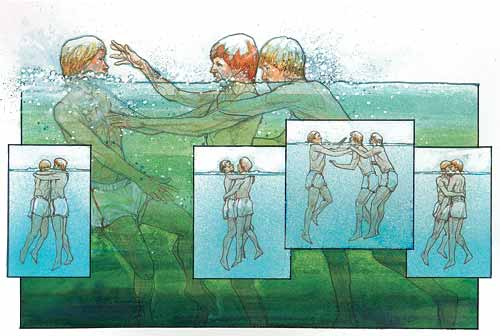![]() May - June 2003
May - June 2003


Breaking the 'Death Grip'
By Keith Monroe
Illustration by Joel Snyder
For years, lifesaving skills included the ability to fight off a panicky would-be drowning victim, until officials studied the reality of water-rescue situations.

We had come to the final—and worst—part of a 10-hour lifesaving course. I'd already demonstrated the ability to swim to a person in distress, manhandle him into position, and bring him to safety. Now we had to break loose from a victim's so-called "death grip"—front and back strangleholds and double wristlocks.
Swimmers playing the victims were expected to respond more fiercely than in reality. It was assumed that overcoming this resistance would give rescuers more confidence.
Our examiner was Harold Terwilliger, a deceptively mild-mannered giant from the American Red Cross (ARC). He traveled, training and testing candidates for BSA waterfront director and ARC water safety instructor. (The two were similar, because Scouting's aquatics experts came from the ARC.)
Fierce victims
Terwilliger was a zealot when testing on the breaks. Students who played "drowners" often heard him call: "Try it again. Unless you grab absolutely tight, I can't pass him."
For my turn as rescuer, I treaded the deep water, eyes closed, until my partner wrapped his massive arms around my neck from behind. I exhaled and went to the bottom with him, as we had been taught, but he held immovably. Twisting his wrist (the prescribed maneuver) didn't work because his wrist was like iron. As a last resort, I thrust my thumb into the back of his hand, gripped his fingers, and twisted outward. His arm came off my throat. With a hammerlock I slid behind, ready to clamp him in a cross-chest carry.
At that instant a second brawny student, sent by Terwilliger, put a bear hug on me. How could I pry off two men at once? Our training didn't cover that.
We were supposed to "signal with a pinch" if we needed to be released by the "drowner." I should have done that, because my breath was gone, but my body ignored my brain. Instead, I put one hand on each man, somehow pushed both away, and shot to the surface.
"Your adrenaline kicked in," Terwilliger said to me, smiling. "You became as strong as a drowning man—and I wanted everyone to see just how strong that is."
I passed the test and qualified to be a camp waterfront director. That was in the 1930's, but in the next 50 years I knew of only one Scout in a real rescue situation who was held in an actual "death grip," when a nonswimmer panicked during a game of "horse-and-rider."
Breaking a stranglehold had been a lifesaving technique since such training first began in the late 19th century. In fact, turn-of-the century rescuers were taught to break a victim's "death grip" by knocking the person unconscious. However, delivering a knockout punch in deep water with no foothold was difficult to impossible, and eventually slightly milder tactics were taught.
The first BSA handbook, the 1911 Handbook for Boys, described these still-violent methods. To break a front stranglehold, a rescuer should "cover the other's mouth, clasping the nostrils tightly," then knee him. When strangled from behind, a rescuer in a "life and death struggle" should "throw his head suddenly back against the nose of the drowning man" and then get him under control "by the time he recovers from his dazed condition."
A slow revolution
Eventually, breaking a "death grip" was de-emphasized and then eliminated from training. This occurred as part of a slow revolution led by Fred C. Mills, who left the ARC in 1925 to organize the BSA health and safety service.
In the early 1920's, to make his Red Cross lifesaving demonstrations more dramatic, Mills had tried to get a victim to tightly embrace his rescuer. But this proved to be impossible when the rescuer ducked or hunched his shoulders, a natural reflex. Mills began to wonder if double fatalities of victim and would-be rescuer really happened.
An analytical man, he traveled widely to investigate. He found no cases of strangleholds, even when many people perished after a ferry sinking.
"I realized that a drowning person fights to stay above water," he recalled. "When a rescuer sinks, the drowner climbs over him to the surface." As a result of Mills's findings, underwater wrestling became obsolete in lifesaving courses.
But BSA officials were concerned that attempted rescues by Scouts frequently failed, often with fatal consequences. And nationwide, drowning was the second most common cause of accidental death, after vehicle crashes.
If death-grip incidents weren't the primary cause, what was?
Details about drowning deaths weren't tabulated, so Mills investigated past Scout fatalities, including 340 successful rescues. He learned that 25 Scouts or leaders had drowned in rescue attempts but none in strangleholds. Also, many would-be rescuers went in fully or partially clothed. "Swimming with their clothes on exhausted them," Mills reported. In other cases, he found, diving into the water caused them to hit the bottom or underwater objects.
As a result, the Lifesaving merit badge requirement to "Swim 50 yards with clothes on" was removed. Instead, Scouts were taught to undress in 20 seconds (thought impossible by many until Mills showed how), to enter the water by jumping, and to submerge when someone reached for them.
New methods
During the 1930's, these "supplementary methods" were introduced throughout the BSA. Although "free yourself from front and rear holds" was kept as a requirement for the Lifesaving merit badge, instructors now taught Scouts to get free by pushing off, or by simply submerging.
Increased emphasis was put on rescue without entering the water, and today Scouts are taught that the preferred order of rescue is "reach, throw, row, and go (with support)." (In fact, since 1911 Scouts had been advised to use a boat and throw a life buoy "when possible." But the 1911 Handbook for Boys offered this advice only after providing details on how to break a stranglehold in the water.)
In the 20 years following the revised instruction, 2,000 successful rescues by Scouts (including dozens by weak swimmers who extended a shirt or towel) were reported. Only one Scout—who dived into the water and hit a submerged automobile—died in a rescue attempt.
The fear of death grips and the violent breaks taught to counter them were no longer part of standard lifesaving instruction.
A frequent contributor to Scouting magazine, Keith Monroe lives in Los Angeles, Calif. His profile of Fred C. Mills, "He Made Scouts Smarter and Safer," appeared in the September 1990 issue.
May-June 2003 Table of Contents
Copyright © 2003 by the Boy Scouts of America. All rights thereunder reserved; anything appearing in Scouting magazine or on its Web site may not be reprinted either wholly or in part without written permission. Because of freedom given authors, opinions may not reflect official concurrence.
| The Boy Scouts of America | http://www.scouting.org |